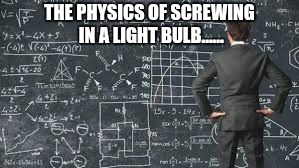

#OVERLY COMPLICATED MATH EQUATION MAKER SERIES#
Here, two series of x and y values diverge markedly over time from a tiny initial difference.
#OVERLY COMPLICATED MATH EQUATION MAKER MOD#
Ĭhaos theory is a method of qualitative and quantitative analysis to investigate the behavior of dynamic systems that cannot be explained and predicted by single data relationships, but must be explained and predicted by whole, continuous data relationships.Ĭhaotic dynamics The map defined by x → 4 x (1 – x) and y → ( x + y) mod 1 displays sensitivity to initial x positions. When meaningful predictions cannot be made, the system appears random. This means, in practice, a meaningful prediction cannot be made over an interval of more than two or three times the Lyapunov time. Hence, mathematically, doubling the forecast time more than squares the proportional uncertainty in the forecast. In chaotic systems, the uncertainty in a forecast increases exponentially with elapsed time. Some examples of Lyapunov times are: chaotic electrical circuits, about 1 millisecond weather systems, a few days (unproven) the inner solar system, 4 to 5 million years. The amount of time for which the behavior of a chaotic system can be effectively predicted depends on three things: how much uncertainty can be tolerated in the forecast, how accurately its current state can be measured, and a time scale depending on the dynamics of the system, called the Lyapunov time. Chaotic systems are predictable for a while and then 'appear' to become random. The theory formed the basis for such fields of study as complex dynamical systems, edge of chaos theory, and self-assembly processes.Ĭhaos theory concerns deterministic systems whose behavior can, in principle, be predicted.


Chaos theory has applications in a variety of disciplines, including meteorology, anthropology, sociology, environmental science, computer science, engineering, economics, ecology, and pandemic crisis management. This behavior can be studied through the analysis of a chaotic mathematical model, or through analytical techniques such as recurrence plots and Poincaré maps. It also occurs spontaneously in some systems with artificial components, such as road traffic. The theory was summarized by Edward Lorenz as: Ĭhaos: When the present determines the future, but the approximate present does not approximately determine the future.Ĭhaotic behavior exists in many natural systems, including fluid flow, heartbeat irregularities, weather, and climate. This behavior is known as deterministic chaos, or simply chaos. In other words, the deterministic nature of these systems does not make them predictable. This can happen even though these systems are deterministic, meaning that their future behavior follows a unique evolution and is fully determined by their initial conditions, with no random elements involved. Small differences in initial conditions, such as those due to errors in measurements or due to rounding errors in numerical computation, can yield widely diverging outcomes for such dynamical systems, rendering long-term prediction of their behavior impossible in general. A metaphor for this behavior is that a butterfly flapping its wings in Texas can cause a tornado in Brazil. The butterfly effect, an underlying principle of chaos, describes how a small change in one state of a deterministic nonlinear system can result in large differences in a later state (meaning that there is sensitive dependence on initial conditions).

Chaos theory states that within the apparent randomness of chaotic complex systems, there are underlying patterns, interconnection, constant feedback loops, repetition, self-similarity, fractals, and self-organization. The double-rod pendulum is one of the simplest dynamical systems with chaotic solutions.Ĭhaos theory is an interdisciplinary area of scientific study and branch of mathematics focused on underlying patterns and deterministic laws of dynamical systems that are highly sensitive to initial conditions, and were once thought to have completely random states of disorder and irregularities. Starting the pendulum from a slightly different initial condition would result in a vastly different trajectory. A plot of the Lorenz attractor for values r = 28, σ = 10, b = 8/3 An animation of a double-rod pendulum at an intermediate energy showing chaotic behavior. For other uses, see Chaos theory (disambiguation).


 0 kommentar(er)
0 kommentar(er)
